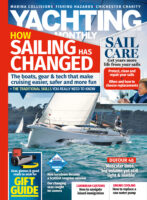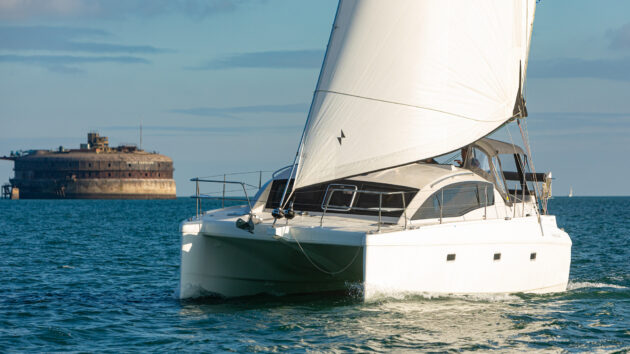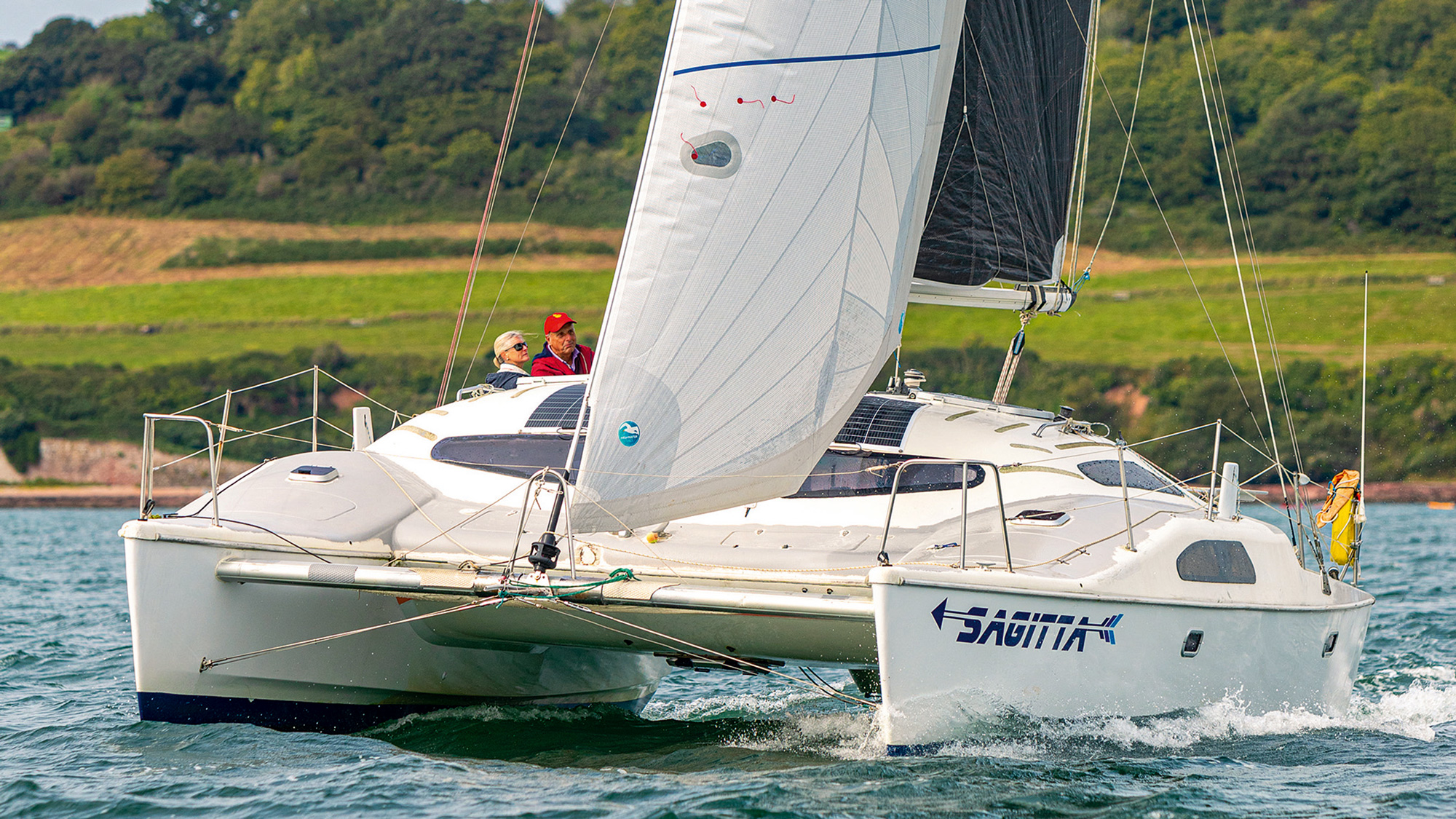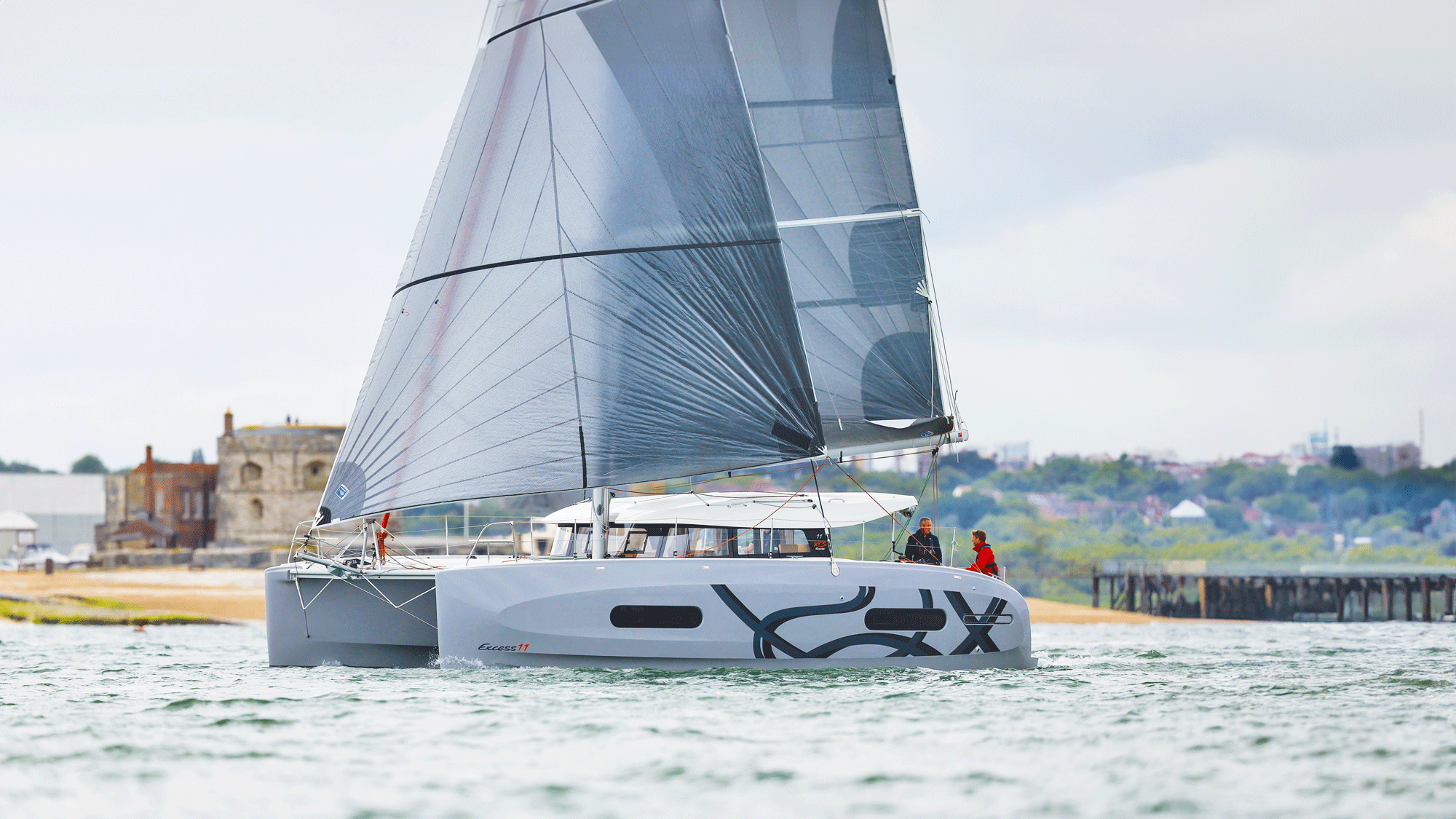A prime example of how to squeeze a quart into a pint pot, the Broadblue 346 also demonstrates the versatility of twin hulls
Broadblue 346 review: A cat with nine lives (well two actually)
Sometimes, if you stick around for long enough, you will see things that appear and then disappear before reappearing some years later. It happens in all areas of life, including yacht design (does anyone still believe that foiling is a new idea?). And, now and again, an actual model of yacht will vanish from the scene before making a comeback – if it’s good enough.
Take the Broadblue 346, for example. She was launched back in 2007 as the Voyager 10, undergoing extensive sea trials before I took her for a spin on the Solent one breezy day the following year. A while later she became the Broadblue 345. Then Broadblue disappeared, and that might have been that as far as the boat was concerned.
As it turned out, that wasn’t that. Broadblue was resurrected, production moved from China to Poland, and the Broadblue 345 was re-introduced in slightly tweaked form as the Broadblue 346.
So it was almost with a sense of déjà vu that I drove to Port Solent last autumn to test the Broadblue 346 with Mark Jarvis of Multihull World, who had been the instigator of the Voyager 10 and was later instrumental in bringing back Broadblue.
Conditions were very different this time. In 2008 we had had up to 30 knots of westerly wind against the tide, leading to a short Solent chop, several rolls in the jib and two reefs in the main. This time we had 7-12 knots from the north. That meant flat water, full sail and the lightweight reacher as soon as we cracked off the wind a few degrees.
I already knew how the boat behaved in brisk conditions, so it was a good opportunity to assess her in the sort of weather in which more people might be inclined to venture forth. And, of course, to see what had changed in the 16 years since my last outing.

Up a couple of steps from the saloon, the cockpit is enormous for a boat of this length. Photo: David Harding
Fulfilling a function
Back in 2008, I noted that the Voyager (as she then was) would have been a lot of things to a lot of people. She was a roomy boat for her length, offering the volume of accommodation that only a cat can.
At the same time, she was by no means slow. Although she disliked some sea states and would never tack through less than 90°, she was capable of making upwind at 6.5 knots even if the water wasn’t completely flat.
Downwind she slid along happily at up to 9 knots and was clearly capable of making fast, comfortable passages. When you got to wherever you were going, you could dry her out happily on her long shallow keels, her draught of 3ft 4in (1.01m) letting you visit places that would be out of bounds to a fin keeled monohull.
If you wanted to go through the French canals, you could. Her beam of 4.85m (15ft 11in) was inside the 5m maximum for the canals, and it also allowed her to use a berth designed for a 14m (46ft) monohull.

Sheets for downwind sails can be led to the winches from the blocks on the quarter by low-friction rings. Photo: David Harding
The ability to sail around the outside to the Med was just as important, so the boat had to have the seakeeping and sail-carrying ability to do this. Stability and sail-carrying ability with cats are largely a function of the total beam and length/beam ratio – 2:1 being considered optimum – so the beam determined her length.
Combining performance and stability with accommodation – including full standing headroom in the saloon – is always a challenge on cats of this size. That explains why the Broadblue has so much freeboard. The higher the bridgedeck, the less the slamming.
At the same time, stability is greater with narrow hulls than with beamy ones, because the centre of buoyancy moves inboard as the hulls’ beam increases. Narrow hulls sink lower in the water, so you need more freeboard to achieve the necessary buoyancy forward without pronounced flare or full forward sections, both of which can lead to more pitching and a less comfortable motion.
Article continues below…
Sagitta 30 review: Good performance and roomy accommodation
For some monohull sailors, multihulls are still from a different planet, or perhaps even a different galaxy. Despite the increasing…
Excess 11 review: A very rare sub-40ft cruising catamaran
Catamarans don’t belong in the UK, I hear you cry. If you’ve been put off by towering topsides, the vast…
There’s a lot to think about with a multi-purpose cat of this size. It’s inevitably a case of form following function, and while the Broadblue 346 might not be the most elegant boat on the water, she is the way she is for a reason. Cats with Darren Newton’s name attached to them are usually sleeker and sportier than the Broadblue, but it’s reassuring to know that the design has a pedigree.
Despite a few years having passed since the design (in Voyager guise) was first introduced, the 346 still combines attributes that you would be hard pressed to find in other cats of this length – not that many new cruising cats of this length are built any more.
In some ways the Broadblue is a modern-day equivalent of boats like Prout’s much lower-profile Snowgoose 34, though these older-generation designs look tiny in comparison and have a fraction of the accommodation.

With a beam of nearly 16ft (4.85m), the Broadblue can carry a 3.2m tender on the stern. Photo: David Harding
Levelling up
Having the galley ‘up’ (on the bridgedeck) is a Broadblue feature. On most older cats of this size, it’s in one of the hulls. Wherever you prefer it, there’s little doubt that ‘up’ is more sociable, especially as the Broadblue has a large hatch that you can open between the galley and cockpit.
A more unusual feature is that the cockpit is not on the same level as the saloon – it’s a couple of steps higher. Therein lies a tale, because cockpit height is one of the major decisions with a catamaran. If you have the saloon and cockpit on the same level, it’s like walking out of your house on to a patio.
Then, however, you need a raised helm station for visibility over the coachroof, so the helm becomes removed from the cockpit and it can be a challenge to see under the headsail. Raising the whole cockpit has the same effect on visibility to leeward. One alternative is to move the wheel aft, where it’s more exposed. Or you can move it forward, into the saloon, as on the Rapier 550. It’s harder to make that work on a smaller boat.

Interior mouldings are used extensively, but there’s still a good amount of trim in light oak below decks. Photo: David Harding
Lines of sight
On the Broadblue, the solution was to raise the cockpit by a small but significant amount. Leaving the saloon, you go up a couple of steps to find the wheel by your right hand. At the helm you’re very much in the cockpit, not perched above it, again making for a much more sociable environment.
For the best all-round view when sitting down, you would choose the raised seats right aft, either side of the access to the stern platform.
It’s a big cockpit, too. Stuart, the owner of our test boat, once had 10 people aboard his previous boat, a Bavaria 37. ‘It was crowded,’ he said. ‘There’s loads more cockpit space here.’
His boat before the Bavaria, which drew 1.95m (6ft 5in), had been a lift-keel Jeanneau Sun Odyssey 35, and he wanted to go back to a boat with shallow draught. Various monohulls were on the list of possibilities, all with deck saloons so he could see out.

A galley over the bridgedeck rather than in one of the hulls is a rare feature on cats of this size. Photo: David Harding
The fact that the Broadblue offered a view from the saloon, together with shallow draught and a lot of space, meant it couldn’t be ignored. It also sailed upright. ‘If you lose your of family and friends because they won’t sail with you, you lose your boat,’ says Stuart. I’m sure a lot of people can relate to that, and will agree with him that comfort becomes more important as you get older.
The Broadblue certainly offers comfort, both below decks and above. During our test we even left the cockpit canopy in position, with only the sides rolled up for easy movement between deck and cockpit.
You can equally well leave them down and sail fully enclosed. All sail handling can be managed from inside the cockpit, using the two winches and the bank of 12 clutches at the forward end within easy reach of the wheel. The mast is stepped on the coachroof almost directly above them, immediately forward of the cockpit.

The master cabin is aft in the starboard hull, occupying nearly half its length. Photo: David Harding
As Mark points out, the proportions of the Broadblue are akin to those of a centre-cockpit boat, particularly in terms of the mast’s position in relation to the cockpit.
Working the lines and the winches is ergonomically easy because of their height and position. You just need to be organised. You can even lead the sheet for the reaching and downwind sails from their blocks on the quarter to the winches via low-friction rings.
Perhaps the aspect of sail-handling that takes most thought when you’re out for a day-sail is managing the twin mainsheets. As a simple and economical alternative to a full-width traveller, twin sheets make a lot of sense on a boat with this much beam when it comes to controlling sail twist and lateral boom position.

In the centre of the port hull is stowage and an optional single berth. A single berth and an optional second heads in the bow. Photo: David Harding
For coastal day-sailing, when you’re manoeuvring frequently, it’s worth adjusting the balance between them if you’re to sail efficiently. If you have the canopy up, you might have to pop your head outside to check the trim now and again.
One aspect of handling on the Broadblue that’s as simple as can be is lowering the mainsail. Go head-to-wind, make sure the halyard is free to run, release the clutch, and it comes all the way down in a trice. You need do no tidying up until you’re back in your berth or on your mooring.
While the main is still up, you can enjoy sailing at a respectable pace for a boat that offers so much space and comfort. On my previous outing, we had clocked up to 6.5 knots to windward in 22 to 30 knots of breeze unless we were brought up short by a series of sharp waves that slowed us to 3-4 knots.

A more unusual feature is that the cockpit is not on the same level as the saloon. Photo: David Harding
This time, on flat water and in a wind of 8-12 knots, we flew the lightweight reacher most of the time, making 6.5-6.7 knots with the apparent wind at 60° and peaking at 9 knots when the anemometer briefly registered 17 knots.
Hard on the wind with the self-tacking jib, we saw 12-14 knots of apparent wind and boat-speeds of 4.5-4.8 knots. That doesn’t sound spectacular, but it enabled us to keep pace with a couple of moderately sporty 28-30ft monohulls as we beat back towards the entrance to Portsmouth Harbour.

You can sail from inside the full cockpit canopy if you like. Photo: David Harding
The power of two
When the time comes to resort to mechanical propulsion, you can fire up either or both of the Beta 16hp (standard) or 20hp saildrives – the same engines that were fitted when the Voyager was launched back in 2007.
As on our test boat, they’re typically paired with Brunton Autoprops, not least because the props’ variable pitch allows them to accommodate a difference in speed between the two engines.
At 2,500rpm, both 20hp engines together will push the boat along at around 5.7 knots. You don’t lose much speed by running just one, as Stuart often does. If you’re in a hurry, opening both throttles all the way will take you closer to 8 knots. Having the props so far apart gives turn-on-the-spot manoeuvrability when you need it.
To reach the engines, you lift the bunks in the aft cabins. The master cabin is to starboard, with a 2m x 1.6m (6ft 6in x 5ft 3in) berth aligned fore-and-aft, plenty of seating and stowage space and a large hatch opening on to the stern platform. A heads and shower compartment occupies the forward part of the starboard hull.

Upwind performance in flat water is better than you might expect from a high-volume cruising cat. Photo: David Harding
To port is a slightly smaller double cabin in the stern, forward of which is a space that can be used for stowage or as a single berth. In the bow you have an optional second heads and another single berth.
The central area over the bridgedeck is the heart of a cruising catamaran. Here we find a saloon with over 6ft of headroom, L-shaped seating to port around the table with its inlaid chessboard,
a sizeable galley aft to starboard and a forward-facing chart table at the forward end.
The finish is in light oak, of which there’s substantially more than on the Voyager.
Broadblue 34 specifications
LOA: 10.20m (33ft 6in)
Beam: 4.85m (15ft 11in)
Draught: 1.01m (3ft 4in)
Displacement: 4,800kg (10,582 lb)
Displacement/length: 135
Sail area (main & self-tacker): 47m2 (506sq ft)
SA/D ratio: 16.8
Diesel: 250L / 55 gal
Water: 400L / 88 gal
Engines: 2 x Beta 16hp or 20hp
Transmission: Saildrive
RCD: category A
Designer: Derick Reynolds, Darren Newton & Mark Jarvis
Builder: Broadblue
Enjoyed reading this?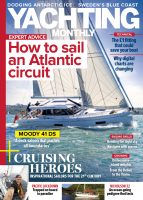
A subscription to Yachting Monthly magazine costs around 40% less than the cover price, so you can save money compared to buying single issues.
Print and digital editions are available through Magazines Direct – where you can also find the latest deals.
YM is packed with information to help you get the most from your time on the water.
-
-
- Take your seamanship to the next level with tips, advice and skills from our experts
- Impartial in-depth reviews of the latest yachts and equipment
- Cruising guides to help you reach those dream destinations
-
Follow us on Facebook, Twitter and Instagram.
Note: We may earn a commission when you buy through links on our site, at no extra cost to you. This doesn’t affect our editorial independence.

